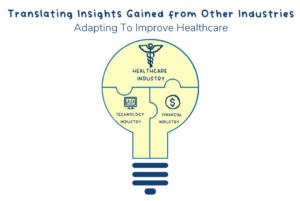How Healthcare Can Be Solved By Learning From Other Industries
The healthcare industry faces complex challenges. While some of these challenges may be unique to the industry, others mirror obstacles facing various industries in the U.S. economy. Observing how those industries dealt with their challenges may provide novel and valuable insights that reveal new solutions in healthcare. If we are to succeed in improving this broken healthcare system, we need to get creative and take to heart lessons from outside our typical perspective.
Improving Employee Engagement Courtesy of Big Tech
Over the last decade, tech companies have developed strategies to get the most out of their employees. One of the most effective involves maximizing employee wellbeing and engagement. The logic is intuitive enough: happy, engaged employees contribute more to their company and foster a better experience for their customers. Microsoft was recently identified in an article by Business Insider as the 3rd most successful company at keeping employees happy and fulfilled. This company prioritizes employee wellbeing by offering legitimate upward mobility, work-from-home opportunities, ample time off, sponsored mental health counseling, and more. Not all of these strategies will be available to every entity in the healthcare industry (smaller providers may lack the resources) but adopting one or more of these kinds of employee support systems could pay dividends. Although most in healthcare believe that the patients are the lifeblood of each organization, you can’t make them happy unless your internal team is content. A team can more effectively adapt to new challenges and find innovative solutions when its members feel fulfilled and appreciated. In a culture where hopping from company to company is commonplace and, in many cases, advantageous, thoughtfully engaging team members can provide a powerful incentive for them to stay long-term.
Data Security Insights from the Banking System
Despite an initial resistance to the adoption of electronic medical records, the American public has in recent years come around to the benefits of online healthcare technology. According to a 2019 KFF study, patients were 8 times more likely to report that electronic medical records improved the quality of their care than to report their care was worsened by it. In order to continue to increase public trust in this and other healthcare technologies, healthcare companies can look to banks for strategies that proved successful in the past. All industries strive to keep consumers’ information secure. In the financial industry, people are increasingly utilizing mobile and online banking, because the technology has proven trustworthy. Healthcare entities can model online healthcare portals around this concept, allowing patients to interact with their healthcare provider on their phones. Increasing patient engagement with online portals and mobile applications can reduce the burden on in-person services at hospitals and other healthcare facilities. It could also increase patient satisfaction by allowing them to seek important services and valuable information at their convenience and from the comfort of their own home.
How Change Happens
According to a 2012 study in the National Center for Biotechnology Information: “The diffusion of innovations from other industries appears to start with a few early adopter organizations (hospitals and health systems)…pushing for the innovations. Once the trend becomes accepted, consultants and copying behavior seem to contribute to its spread across the industry.” There is no one-size-fits-all solution for fixing healthcare at its core. Translating and adapting improvements to healthcare is a daunting task; initial enthusiasm for oversimplified, large-scale attempts to apply a new improvement technique often quickly gives way to confusion, complication, and criticism. Despite these difficulties, change happens when someone has a vision for a better future and works to create it, accepting all the risks inherent in such an endeavor. The history of industry is the history of innovation. We rely on these new innovations to propel us forward and make the world a better place for its inhabitants. The companies that produce these innovations are the ones who thrive. They are the ones who take calculated risks, introducing novel concepts and technologies into the market. It is clear that someone is going to make sweeping changes to healthcare at some point in the future, likely using wisdom gleaned from other industries. That someone can either be us, the connected world of Enlace Health and our partners, doing it the right way, or someone else doing it their way. Warning: you may not like their way.

The Path to Healthcare Improvement
The history of industry is the history of innovation. We rely on these new innovations to propel us forward and make the world a better place for its inhabitants. The companies that produce these innovations are the ones who thrive. They are the ones who take calculated risks, introducing novel concepts and technologies into the market.
There is no one-size-fits-all solution for fixing healthcare at its core. Translating and adapting improvements to healthcare is a daunting task; initial enthusiasm for oversimplified, large-scale attempts to apply a new improvement technique often quickly gives way to confusion, complication, and criticism. However, with the assistance of an experienced guide, such as Enlace Health, substantial changes are likely to be more efficient, cost effective, and reduce the potential for error.
References:
Top Three Things Healthcare Can Learn from Other Industries
Can we import improvements from industry to healthcare?
Health Care Learning from Other Sectors
“Learning” from other industries: lessons and challenges for health care organizations
Data Note: Public’s Experiences With Electronic Health Records
The top 25 companies where employees feel happy and fulfilled
 ASK ENLACE
ASK ENLACE